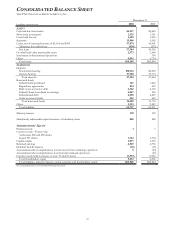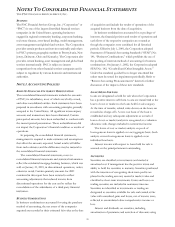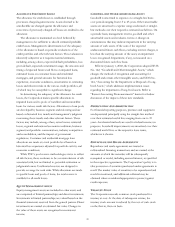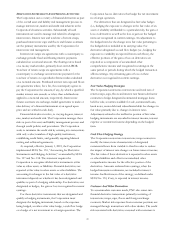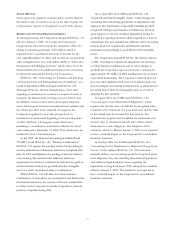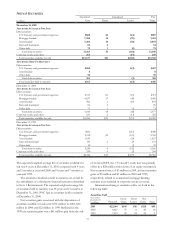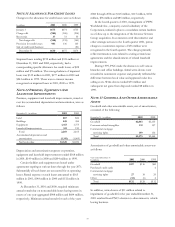PNC Bank 2001 Annual Report Download - page 73
Download and view the complete annual report
Please find page 73 of the 2001 PNC Bank annual report below. You can navigate through the pages in the report by either clicking on the pages listed below, or by using the keyword search tool below to find specific information within the annual report.71
STOCK OPTIONS
Stock options are granted at exercise prices not less than the
fair market value of common stock on the date of grant. No
compensation expense is recognized on such stock options.
RECENT ACCOUNTING PRONOUNCEMENTS
As stated previously, the Corporation adopted SFAS No. 133
effective January 1, 2001. As a result, the Corporation
recognized an after-tax loss from the cumulative effect of a
change in accounting principle of $5 million, which is
reported in the consolidated statement of income for the
year ended December 31, 2001, and an after-tax accumulated
other comprehensive loss of $4 million. Refer to “Derivative
Instruments and Hedging Activities” herein and to Note 20
Financial Derivatives for additional detail on the accounting
for derivative instruments held by the Corporation.
SFAS No. 140, “Accounting for Transfers and Servicing
of Financial Assets and Extinguishments of Liabilities,” was
issued in September 2000 and replaced SFAS No. 125.
Although SFAS No. 140 has changed many of the rules
regarding securitizations, it continues to require an entity to
recognize the financial and servicing assets it controls and
the liabilities it has incurred and to derecognize financial
assets when control has been surrendered in accordance with
the criteria provided in the standard. As required, the
Corporation applied the new rules prospectively to
transactions consummated beginning in the second quarter
of 2001. SFAS No. 140 requires certain disclosures
pertaining to securitization transactions effective for fiscal
years ending after December 15, 2000. These disclosures are
included in Note 14 Securitizations.
In July 2001, the Financial Accounting Standards Board
(“FASB”) issued SFAS No. 141, “Business Combinations.”
SFAS No. 141 requires the purchase method of accounting be
used for all business combinations initiated or completed after
June 30, 2001 and eliminates the pooling-of-interests method
of accounting. The statement also addresses disclosure
requirements for business combinations and initial recognition
and measurement criteria for goodwill and other intangible
assets as a result of purchase business combinations.
While SFAS No. 141 will affect how future business
combinations, if undertaken, are accounted for and disclosed in
the financial statements, the issuance of the new standard had
no effect on the Corporation’s results of operations, financial
position, or liquidity during 2001.
Also in July 2001, the FASB issued SFAS No. 142,
“Goodwill and Other Intangible Assets,” which changes the
accounting from amortizing goodwill to an impairment-only
approach. The amortization of goodwill, including goodwill
recognized relating to past business combinations, will cease
upon adoption of the new standard. Impairment testing for
goodwill at a reporting unit level will be required on at least an
annual basis. The new standard also addresses other accounting
matters, disclosure requirements and financial statement
presentation issues relating to goodwill and other intangible
assets.
The Corporation adopted SFAS No. 142 effective January
1, 2002. Assuming no impairment adjustments are necessary,
no future business combinations and no other changes to
goodwill, the Corporation expects net income to increase by
approximately $93 million in 2002 resulting from the cessation
of goodwill amortization. The Corporation currently does not
have any other indefinite-lived assets on its balance sheet, nor
does it anticipate any material reclassifications or adjustments to
the useful lives of finite-lived intangible assets as a result of
adopting the new standard.
In August 2001, the FASB issued SFAS No. 143,
“Accounting for Asset Retirement Obligations,” which
requires that the fair value of a liability be recognized when
incurred for the retirement of a long-lived asset and the value
of the related asset be increased by that amount. The
statement also requires that the liability be maintained at its
present value in subsequent periods and outlines certain
disclosures for such obligations. The adoption of this
statement, which is effective January 1, 2003, is not expected
to have a material impact on the Corporation’s consolidated
financial statements.
In October 2001, the FASB issued SFAS No. 144,
“Accounting for the Impairment or Disposal of Long-Lived
Assets,” which replaces SFAS No. 121. This statement
primarily defines one accounting model for long-lived assets
to be disposed of by sale, including discontinued operations,
and addresses implementation issues regarding the
impairment of long-lived assets. PNC adopted this standard
effective January 1, 2002. The standard is not expected to
have a material impact on the Corporation’s consolidated
financial statements.




